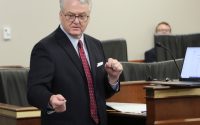In Los Angeles, a Growing Sense That ‘Historic’ Weather Is Becoming Normal
Californians have long joked that their state has three seasons: wildfire, earthquake and flood. But as an atmospheric river parked itself over Los Angeles this week, knocking out power and dumping record rainfall, there was a serious coming to terms.
“The weather seems more extreme on every level,” Fred Rosen, a retired entertainment executive, said on Monday, hunkering in the lobby of the nearby Hotel Bel-Air as mudslides threatened his neighborhood. “But where are you going to go?”
The relentless weather system has hammered Southern California from Santa Barbara to San Bernardino since Sunday, and the authorities so far have reported more than 380 mudslides in Los Angeles alone. Rescuers have plucked dozens of people from raging waters, and homeless people have filled shelters.
It has always rained during the winter in Los Angeles, never mind the song that says otherwise. But the succession of extreme weather events — an onslaught of storms a year ago, Tropical Storm Hilary in August and now this marathon of atmospheric rivers — has made Angelenos think that such “historic” occurrences may not be so historic anymore in an era of climate change.
In the Baldwin Hills neighborhood, mud oozed onto a road, trapping several cars and blocking traffic after shoving past a barrier that a resident had installed in a futile attempt to turn back nature. Nearby, a mountain of soil had blown through a bedroom wall, a concerning scene that Mayor Karen Bass examined herself.
Last winter, a similar slide had occurred during a storm, Loratious Presley said as he surveyed neighborhood damage under a red umbrella. That left him with a valuable lesson: Park in a new place. His own car was spared, but others were not so fortunate.
“The last two years, there’s been nothing like it,” Mr. Presley said.
Katy Yaroslavsky, the City Council member representing West Los Angeles, concurred. Parts of her district received almost as much rainfall on Sunday and Monday as they receive in an average year.
“People say this is the new normal, but, like the rest of the world, even that has changed here,” said the councilwoman, whose district encompasses some 260,000 Angelenos. “I don’t even know what to call this. The new ‘new normal’? What does ‘normal’ even mean anymore?”
Inside the Beverly Glen Deli nestled in the Santa Monica Mountains, Paul Mudra, 58, called the storm “a little worrisome” but nothing dire for those accustomed to living under the threat of wildfire and earthquakes. “In a way, the rains are just one more natural disaster we have to contend with,” added his husband, Thilo Huebner, 50.
Laurence Homolka, 79, a retired violin teacher who has lived in the mudslide-prone Pacific Palisades neighborhood for the past two decades, wondered over an afternoon coffee at Starbucks whether the growing attention to climate change had simply made Californians “more catastrophe-minded.” When he was 4, he said, it once rained for days and “nobody thought anything about it.”
“Today we have a whole lot of terminology that we have developed. We say it’s catastrophic, which, I think, sometimes it is,” he said. “We’re not able to be OK with what’s actually happening.”
Last week, Los Angeles officials and National Weather Service meteorologists warned residents in stern language to stay off the roads if possible and to evacuate when told. Los Angeles officials marveled on Tuesday that no one in the city had yet been killed.
As the storm moved into Southern California on Sunday, the entertainment world was transfixed on the Grammy Awards in downtown Los Angeles, no matter how dire the warnings were from Mayor Bass to stay home. Inside Crypto.com Arena, the only hint that the weather was a bother was when Miley Cyrus, her hair only slightly disheveled, mentioned that she had nearly missed winning her award for best pop solo performance because traffic had been clogged by the rain.
Even so, much of Los Angeles became a mud bath within hours. In the San Fernando Valley, more than 100 homeless people were evacuated from a tiny-home village. In Studio City, on Lockridge Road, a street tucked into the base of a steep hillside, shocked residents in galoshes wandered through coursing water on roads covered with wet dirt and boulders. Household items poked through the muck — bedding, chunks of plastic, stray shoes.
In several ways, the same storm had more brutal effects in Northern California because intense winds knocked down hundreds of trees, killing three people and cutting power to more than 800,000 households on Sunday.
In Southern California, where the vast sprawl ranges from rugged terrain to tidy subdivisions, the sheer geography can exempt whole stretches from the worst of an extreme storm. Weather that is widely assured to be dangerous and life-threatening can be experienced differently depending on where you’re sitting.
On Monday morning, Cecily Kim Oh, 51, received the urgent warnings about staying off the streets but saw that they did not match the smooth route to her children’s school in North Hollywood that was promised on Google Maps. There were no major backups on Highway 101, nor were any intersections marked as closed.
Ms. Oh has lived in Los Angeles for 15 years and has no complaints about the rain. “Even though it’s cold weather, I’m still barefoot,” she said with a laugh, lifting her foot from the pedal well of her Jeep as she waited outside Walter Reed Middle School.
More than 60 miles south in a canyon of Orange County, a similar feeling played out at the Trabuco General Store, in an area that was under a voluntary evacuation warning. Greeting customers was Zac Schraff, 28, an employee who said he had grown up in the area and went to school across the street. The weather conditions had seemingly worsened over the years, but he said he welcomed the storm.
“Rain can only be a positive thing for us. We’re in a drought. I’m more afraid of the fires,” Mr. Schraff said. But he does often think about the ill-fated cycle where rain feeds the vegetation that could become the fuel for future fires.
Outside the store, Eliceo Marquisa, 58, pointed to a waterway filled about three feet high and scoffed: “That’s nothing,” he said.
He recalled a storm about a decade ago in which the water rose much higher. A resident of Trabuco Canyon for 15 years, Mr. Marquisa said he had grown used to the severe weather and had no plans to ever leave.
The rain made rich and poor alike vulnerable to the devastation. Some of the hardest-hit neighborhoods were in the affluent, and saturated, Santa Monica Mountains and Hollywood Hills.
In Bel Air, an intensely private West Los Angeles enclave whose residents have included Lady Gaga and Ronald Reagan, several people said the storm was a rude awakening. By late afternoon on Monday, multimillion-dollar homes, buttressed by powerful retaining walls and ringed with security hedges, had been drenched with a mind-boggling 11.68 inches of rain, according to the Weather Service.
At the Hotel Bel-Air, the Swan Lake grotto, a well-known wedding venue, was a river of brown water.
“It was an absolute disaster,” said Mahin White, 78, who has lived in Bel Air for 43 years and said she was living at the hotel while her home was being remodeled. “No swans were in it, thank God.”
Kyle Armantrout, 51, said that when the ground outside his five-bedroom house began to rumble on Sunday, he thought it was an earthquake. Then he checked his security cameras, he said, and realized that the hillside across the street had collapsed into his and his neighbor’s front yards.
The debris had damaged his neighbor’s house more, smashing a gate and breaking through a garage door, Mr. Armantrout said. But something inexorable about the event has left him unnerved.
“We’ve had nearly a foot of rain in 24 hours,” he said. “You’d think it would be torrential, but it’s just been so steady. Constant. That’s the part that makes you think, ‘What if it doesn’t stop?’”
Rachel Parsons, Vik Jolly and Colleen Hagerty contributed reporting from Los Angeles, and Rebecca Shin from Orange County, Calif.


